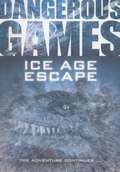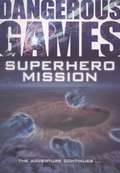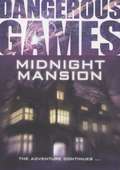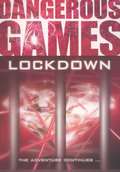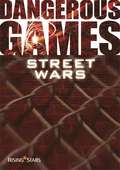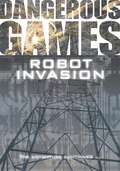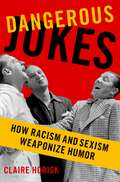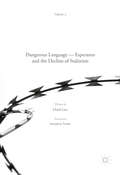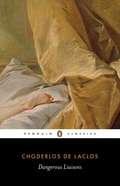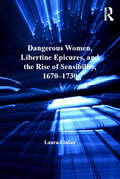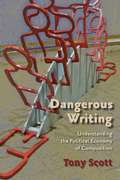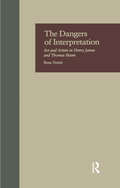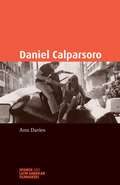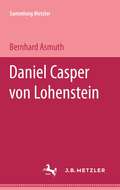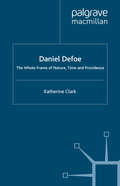- Table View
- List View
Dangerous Games: Ice Age Escape (PDF)
by Sue GravesThe titles in the 'Dangerous Games' series takes Tom, Sima and Kojo inside the computer games they create and into more thrilling and daring settings.
Dangerous Games: Superhero Mission (PDF)
by Sue GravesThe titles in the 'Dangerous Games' series takes Tom, Sima and Kojo inside the computer games they create and into more thrilling and daring settings.
Dangerous Games: Midnight Mansion (PDF)
by Sue GravesThe titles in the 'Dangerous Games' series takes Tom, Sima and Kojo inside the computer games they create and into more thrilling and daring settings.
Dangerous Games: Lockdown (PDF)
by Sue GravesThe titles in the 'Dangerous Games' series takes Tom, Sima and Kojo inside the computer games they create and into more thrilling and daring settings.
Dangerous Games: Street Wars (PDF)
by Sue GravesSima, Kojo and Tom work for Dangerous Games, a software design company. Each story in this series sees the three best friends tackle deadly situations as they enter a real-life version of their game.
Dangerous Games: Street Wars (PDF)
by Sue GravesSima, Kojo and Tom work for Dangerous Games, a software design company. Each story in this series sees the three best friends tackle deadly situations as they enter a real-life version of their game.
Dangerous Games, Stage 10, White: Robot Invasion (PDF)
by Sue GravesThis exciting series of adventure stories features a trio of computer games designers testing out their work for real, entering new virtual worlds and encountering exciting and sometimes deadly situations! Graphic-novel style fiction, tried and tested with the most reluctant readers at Key Stages 2 and 3. Supports progression - the reading age increases as you move through the series. Reading age: 8.5. Interest age: 9.
Dangerous Giving in Nineteenth-Century American Literature (American Literature Readings in the 21st Century)
by Alexandra UrakovaThis book explores the dark, unruly, and self-destructive side of gift-giving as represented in nineteenth-century literary works by American authors. It asserts the centrality and relevance of gift exchange for modern American literary and intellectual history and reveals the ambiguity of the gift in various social and cultural contexts, including those of race, sex, gender, religion, consumption, and literature. Focusing on authors as diverse as Emerson, Kirkland, Child, Sedgwick, Hawthorne, Poe, Douglass, Stowe, Holmes, Henry James, Twain, Howells, Wilkins Freeman, and O. Henry as well as lesser-known, obscure, and anonymous authors, Dangerous Giving explores ambivalent relations between dangerous gifts, modern ideology of disinterested giving, and sentimental tradition.
Dangerous Jokes: How Racism and Sexism Weaponize Humor
by Claire HoriskPeople often get away with belittling others if they frame their speech as jokes-speech that would be condemned if stated seriously. "It's just a joke," they say. But what is different or special about joking? And if jokes about lawyers and politicians are morally acceptable, then what is wrong with joking about race or gender? Furthermore, if we may joke about a politician's shirts, may we joke about his weight? People who are targeted by demeaning jokes feel their impact but may not be able to pinpoint where the harm lies. Dangerous Jokes develops a novel, well-researched, and compelling argument that lays bare the power of demeaning jokes in ordinary conversations. Claire Horisk draws on her expertise in philosophy of language and on evidence from sociology, law and cognitive science to explain how the element of humor-so often used as a defence-makes jokes more potent than regular speech in communicating prejudice and reinforcing social hierarchies. She addresses the morality of telling, being amused by, and laughing at, derogatory jokes, and she gives a new account of listening that addresses the morality of listening to demeaning speech. She leaves us with no illusions about whether "it's just a joke" is an excuse for demeaning humor.
Dangerous Jokes: How Racism and Sexism Weaponize Humor
by Claire HoriskPeople often get away with belittling others if they frame their speech as jokes-speech that would be condemned if stated seriously. "It's just a joke," they say. But what is different or special about joking? And if jokes about lawyers and politicians are morally acceptable, then what is wrong with joking about race or gender? Furthermore, if we may joke about a politician's shirts, may we joke about his weight? People who are targeted by demeaning jokes feel their impact but may not be able to pinpoint where the harm lies. Dangerous Jokes develops a novel, well-researched, and compelling argument that lays bare the power of demeaning jokes in ordinary conversations. Claire Horisk draws on her expertise in philosophy of language and on evidence from sociology, law and cognitive science to explain how the element of humor-so often used as a defence-makes jokes more potent than regular speech in communicating prejudice and reinforcing social hierarchies. She addresses the morality of telling, being amused by, and laughing at, derogatory jokes, and she gives a new account of listening that addresses the morality of listening to demeaning speech. She leaves us with no illusions about whether "it's just a joke" is an excuse for demeaning humor.
Dangerous Language — Esperanto and the Decline of Stalinism
by Ulrich Lins Humphrey TonkinThis book examines the rise of the international language Esperanto, launched in 1887 as a proposed a solution to national conflicts and a path to a more tolerant world. The chapters in this volume examine the position of Esperanto in Eastern Europe during the Cold War; in particular it explores Stalin’s final years and the gradual re-emergence of the Esperanto movement. At first, its revival was limited to the satellite countries, especially Bulgaria and Poland, but, with Stalinism’s gradual retreat, Esperanto organizations reappeared in most East European countries and eventually in the Soviet Union itself. The progress was uneven, and its details reveal the stresses and strains that became apparent as the solidarity of the Soviet bloc declined. This book will appeal to a wide readership, including linguists, historians, political scientists and others interested in the history of the twentieth century from the unusual perspective of language. This volume is complemented by the sister volume Dangerous Language — Esperanto under Hitler and Stalin which offers a concentration on the creation and early emergence of Esperanto as an international language.
Dangerous Language — Esperanto and the Decline of Stalinism
by Ulrich Lins Humphrey TonkinThis book examines the rise of the international language Esperanto, launched in 1887 as a proposed a solution to national conflicts and a path to a more tolerant world. The chapters in this volume examine the position of Esperanto in Eastern Europe during the Cold War; in particular it explores Stalin’s final years and the gradual re-emergence of the Esperanto movement. At first, its revival was limited to the satellite countries, especially Bulgaria and Poland, but, with Stalinism’s gradual retreat, Esperanto organizations reappeared in most East European countries and eventually in the Soviet Union itself. The progress was uneven, and its details reveal the stresses and strains that became apparent as the solidarity of the Soviet bloc declined. This book will appeal to a wide readership, including linguists, historians, political scientists and others interested in the history of the twentieth century from the unusual perspective of language. This volume is complemented by the sister volume Dangerous Language — Esperanto under Hitler and Stalin which offers a concentration on the creation and early emergence of Esperanto as an international language.
Dangerous Language — Esperanto and the Decline of Stalinism
by Humphrey Tonkin Ulrich LinsThis book examines the rise of the international language Esperanto, launched in 1887 as a proposed a solution to national conflicts and a path to a more tolerant world. The chapters in this volume examine the position of Esperanto in Eastern Europe during the Cold War; in particular it explores Stalin’s final years and the gradual re-emergence of the Esperanto movement. At first, its revival was limited to the satellite countries, especially Bulgaria and Poland, but, with Stalinism’s gradual retreat, Esperanto organizations reappeared in most East European countries and eventually in the Soviet Union itself. The progress was uneven, and its details reveal the stresses and strains that became apparent as the solidarity of the Soviet bloc declined. This book will appeal to a wide readership, including linguists, historians, political scientists and others interested in the history of the twentieth century from the unusual perspective of language. This volume is complemented by the sister volume Dangerous Language — Esperanto under Hitler and Stalin which offers a concentration on the creation and early emergence of Esperanto as an international language.
Dangerous Language — Esperanto under Hitler and Stalin
by Ulrich LinsThis is Volume 1 of Dangerous Language. This book examines the rise of the international language Esperanto, launched in 1887 as a proposed solution to national conflicts and a path to a more tolerant world. The chapters in this volume chart the emergence of Esperanto as an answer to a widespread democratic desire for direct person-to-person international communication regardless of political boundaries. Its early success was limited, mostly because of the Czarist regime's suspicion of direct communication with foreigners, and, later, similar suspicion by dictatorial regimes generally. As speakers of a "dangerous language," its adepts were harassed and persecuted, especially in Germany and the Soviet Union. This book argues that the fate of Esperanto over the 130 years of its existence serves as a barometer to measure the degree to which regimes tolerate spontaneous personal contact with other countries and allow the pursuit of self-education outside prescribed national or ideological constraints. This book will appeal to a wide readership, including linguists, historians, political scientists and others interested in the history of the twentieth century from the unusual perspective of language. This volume is complemented by the sister volume Dangerous Language - Esperanto and the Decline of Stalinism which offers a concentration on the Cold War history of Esperanto in Eastern Europe.
Dangerous Liaisons: A Play In Three Acts (Wordsworth Classics Ser.)
by Choderlos De Laclos Helen ConstantinePublished in 1782, just years before the French Revolution, Les Liaisons Dangereuses is a disturbing and ultimately damning portrayal of a decadent society. At its centre are two aristocrats, former lovers, who embark on a sophisticated game of seduction and manipulation to bring amusement to their jaded existences. While the Marquise de Merteuil challenges the Vicomte de Valmont to seduce an innocent convent girl, the Vicomte is also occupied with the conquest of a virtuous married woman. But as their intrigues become more duplicitous and they find their human pawns responding in ways they could not have predicted, the consequences prove to be more serious, and deadly, than Merteuil and Valmont could have guessed.
Dangerous Multilingualism: Northern Perspectives on Order, Purity and Normality (Language and Globalization)
by Jan Blommaert, Sirpa Leppänen, Päivi Pahta, Tiina RäisänenFocuses on the endangering effects of language-ideological processes. This book looks at the challenges imposed by globalization and super-diversity on the nation state and its language situations and ideologies, and demonstrates how many of its problems rise from the tension between late-modern diversity and the (pre-)modernist responses to it.
Dangerous Women, Libertine Epicures, and the Rise of Sensibility, 1670-1730
by Laura LinkerIn the first full-length study of the figure of the female libertine in late seventeenth- and early eighteenth-century literature, Laura Linker examines heroines appearing in literature by John Dryden, Aphra Behn, Catharine Trotter, Delariviere Manley, and Daniel Defoe. Linker argues that this figure, partially inspired by Epicurean ideas found in Lucretius's De rerum natura, interrogates gender roles and assumptions and emerges as a source of considerable tension during the late Stuart and early Georgian periods. Witty and rebellious, the female libertine becomes a frequent satiric target because of her transgressive sexuality. As a result of negative portrayals of lady libertines, women writers begin to associate their libertine heroines with the pathos figures they read in French texts of sensibilité. Beginning with a discussion of Charles II's mistresses, Linker shows that these women continue to serve as models for the female libertine in literature long after their "reigns" at court ended. Her study places the female libertine within her cultural, philosophical, and literary contexts and suggests new ways of considering women's participation and the early novel, which prominently features female libertines as heroines of sensibility.
Dangerous Women, Libertine Epicures, and the Rise of Sensibility, 1670-1730
by Laura LinkerIn the first full-length study of the figure of the female libertine in late seventeenth- and early eighteenth-century literature, Laura Linker examines heroines appearing in literature by John Dryden, Aphra Behn, Catharine Trotter, Delariviere Manley, and Daniel Defoe. Linker argues that this figure, partially inspired by Epicurean ideas found in Lucretius's De rerum natura, interrogates gender roles and assumptions and emerges as a source of considerable tension during the late Stuart and early Georgian periods. Witty and rebellious, the female libertine becomes a frequent satiric target because of her transgressive sexuality. As a result of negative portrayals of lady libertines, women writers begin to associate their libertine heroines with the pathos figures they read in French texts of sensibilité. Beginning with a discussion of Charles II's mistresses, Linker shows that these women continue to serve as models for the female libertine in literature long after their "reigns" at court ended. Her study places the female libertine within her cultural, philosophical, and literary contexts and suggests new ways of considering women's participation and the early novel, which prominently features female libertines as heroines of sensibility.
Dangerous Writing: Understanding the Political Economy of Composition
by Tony ScottBuilding on recent work in rhetoric and composition that takes an historical materialist approach, Dangerous Writing outlines a political economic theory of composition. The book connects pedagogical practices in writing classes to their broader political economic contexts, and argues that the analytical power of students’ writing is prevented from reaching its potential by pressures within the academy and without, that tend to wed higher education with the aims and logics of “fast-capitalism.” Since the 1980s and the “social turn” in composition studies and other disciplines, scholars in this field have conceived writing in college as explicitly embedded in socio-rhetorical situations beyond the classroom. From this conviction develops a commitment to teach writing with an emphasis on analyzing the social and political dimensions of rhetoric. Ironically, though a leftist himself, Tony Scott’s analysis finds the academic left complicit with the forces in American culture that tend, in his view, to compromise education. By focusing on the structures of labor and of institutions that enforce those structures, Scott finds teachers and administrators are too easily swept along with the inertia of a hyper-commodified society in which students---especially working class students---are often positioned as commodities, themselves. Dangerous Writing, then, is a critique of the field as much as it is a critique of capitalism. Ultimately, Scott’s eye is on the institution and its structures, and it is these that he finds most in need of transformation.
The Dangers of Interpretation: Art and Artists in Henry James and Thomas Mann (Origins of Modernism)
by Ilona TreitelFirst published in 1996. This comparative study investigates thematic and technical similarities in the works of the two authors who shared a cultural heritage and achieved comparable status in their separate literary traditions. Drawing upon theories by Bloom, Bakhtin, and Lacan, the book examines ways in which Henry James and Thomas Mann treat the creative artist and analyze the creative and interpretive processes in their fiction. The texts covered range from early works to their great modern novels: The Golden Bowland Doctor Faustus To a great extent, the similarities between the works stem from the authors' preoccupation with artistic responsibility. Adopting Bloom's claim that the creative activity is an interpretive one, and that the reader, as well as the writer, interprets a text into being the book also investigates the reader's responsibility in confronting the dilemmas challenging James' and Mann's artist figures. Such challenges are "the dangers of interpretation" discussed in this book. Index. Bibliography.
The Dangers of Interpretation: Art and Artists in Henry James and Thomas Mann (Origins of Modernism #8)
by Ilona TreitelFirst published in 1996. This comparative study investigates thematic and technical similarities in the works of the two authors who shared a cultural heritage and achieved comparable status in their separate literary traditions. Drawing upon theories by Bloom, Bakhtin, and Lacan, the book examines ways in which Henry James and Thomas Mann treat the creative artist and analyze the creative and interpretive processes in their fiction. The texts covered range from early works to their great modern novels: The Golden Bowland Doctor Faustus To a great extent, the similarities between the works stem from the authors' preoccupation with artistic responsibility. Adopting Bloom's claim that the creative activity is an interpretive one, and that the reader, as well as the writer, interprets a text into being the book also investigates the reader's responsibility in confronting the dilemmas challenging James' and Mann's artist figures. Such challenges are "the dangers of interpretation" discussed in this book. Index. Bibliography.
Daniel Calparsoro (Spanish and Latin-American Filmmakers)
by Ann DaviesDaniel Calparsoro, a director who has provided a crucial contribution to the contemporary scene in Spanish and Basque cinema, has provoked strong reactions from the critics. Reductively dismissed as a purveyor of crude violence by those critics lamenting a 'lost golden age' of Spanish filmmaking, Calparsoro’s films reveal in fact a more complex interaction with trends and traditions in both Spanish and Hollywood cinema. This book is the first full-length study of the director’s work, from his early social realist films set in the Basque Country to his later forays into the genres of the war and horror film. It offers an in-depth film-by-film analysis, while simultaneously exploring the function of the director in the contemporary Spanish context, the tension between directors and critics, and the question of national cinema in an area – the Basque Country – of heightened national and regional sensitivities.
Daniel Calparsoro (Spanish and Latin-American Filmmakers)
by Ann DaviesDaniel Calparsoro, a director who has provided a crucial contribution to the contemporary scene in Spanish and Basque cinema, has provoked strong reactions from the critics. Reductively dismissed as a purveyor of crude violence by those critics lamenting a 'lost golden age' of Spanish filmmaking, Calparsoro’s films reveal in fact a more complex interaction with trends and traditions in both Spanish and Hollywood cinema. This book is the first full-length study of the director’s work, from his early social realist films set in the Basque Country to his later forays into the genres of the war and horror film. It offers an in-depth film-by-film analysis, while simultaneously exploring the function of the director in the contemporary Spanish context, the tension between directors and critics, and the question of national cinema in an area – the Basque Country – of heightened national and regional sensitivities.
Daniel Defoe: The Whole Frame of Nature, Time and Providence
by K. ClarkThis book offers a comprehensive analysis of Defoe's oeuvre from the perspective of the historian. Clark presents Defoe by recovering the theological basis of his intellectual commitments, establishing him as a crucial figure in the evolution of theories about war and property, conquest and commerce, religious toleration and civil society.
